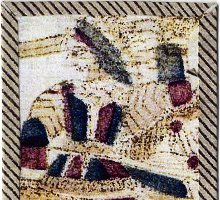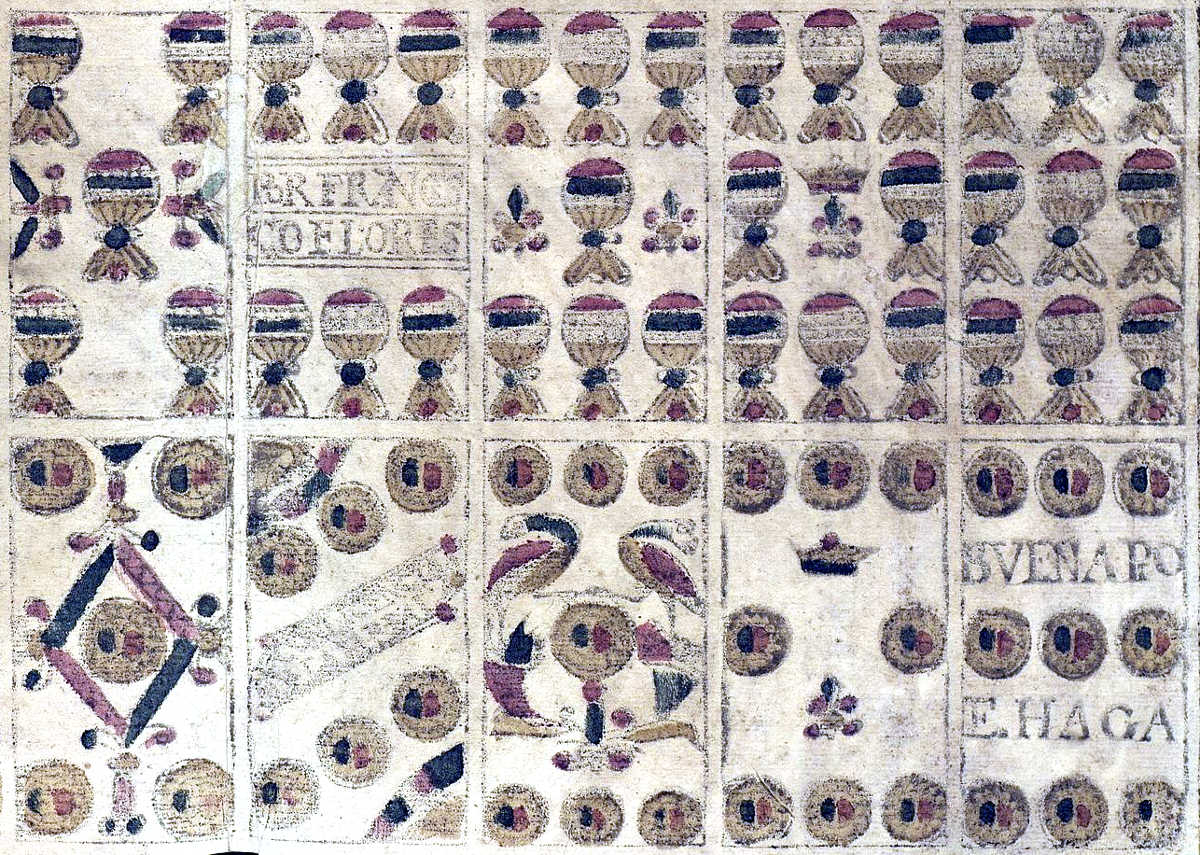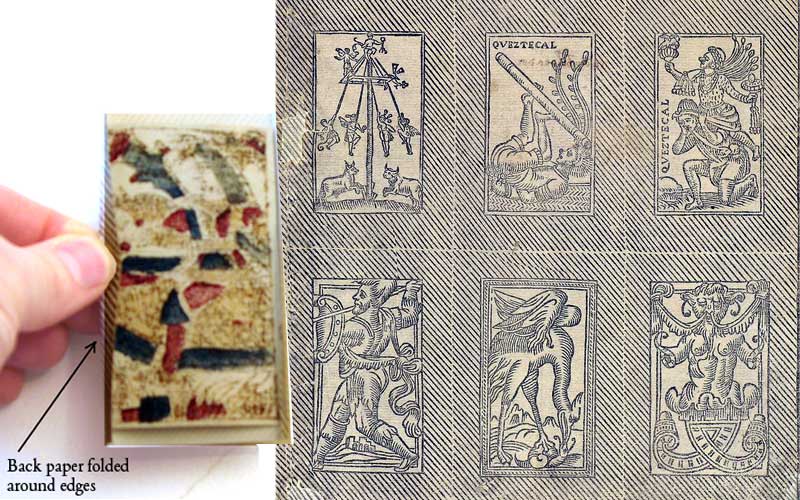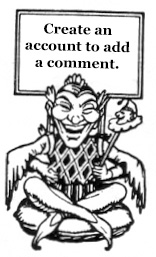Francisco Flores
Playing cards in this style have been discovered in various parts of the world, suggesting that they were exported or carried there by early explorers or merchants.
Archaic 16th century Spanish playing cards by Francisco Flores

This example of so-called "Dragon" cards was printed by Francisco Flores in Spain sometime around the mid-sixteenth century. There are several interesting features to be noted. The four aces depict fearsome monsters or "dragons" with long tails and wings, holding their respective suit symbol in their mouths. The kings are seated on thrones in the Italian style, the knights are on horseback and the maids (or valets) are female, a characteristic seen in other early Spanish packs. The suit symbols of swords, coins, cups and batons are in an archaic style with straight, overlapping swords and batons. Many of these features are echoed in other early examples of playing cards from Spain and Italy, including in many cases the 'turned over' edges where the back paper is folded around the edges of the cards to produce a margin around the fronts (see image below).
Spain’s First Exportation pattern?
Playing cards in this style have been discovered in various parts of the world, suggesting that they were exported or carried there by early explorers or merchants. For example, cards derived from this style have been found in Japan, believed to have been carried there by Portuguese explorers. Similarly, cards of this type have been discovered in an old house in Antwerp. Another exciting discovery has been made in an archaeological excavation in Peru which suggests that these cards may also have been a prototype for the earliest cards used in Spanish colonies in the Americas, from Mexico down to Peru… perhaps the first 'exportation' pattern. The pattern has virtually died out today, although it survived into the nineteenth century when it was produced by Belgian manufacturers for export to Brazil.
Above: hand-made facsimile of cards printed by Francisco Flores (using the originals shown below).

Above: detail from one of the uncut sheets of archaic sixteenth century Spanish playing cards by Francisco Flores, preserved in the Archivo de Indias, Seville.
A set of three uncut sheets of these playing cards is currently preserved in the Archivo de Indias, Seville (Spain) along with a sheet of back designs depicting Mexican, mythological and Italianate 'grotesque' themes (shown below) and the original dossier and contract granted to Alonso Martinez de Orteguilla to supply playing cards to 'New Spain' (i.e. Mexico, as well as Nicaragua, Guatemala and Honduras) in 1583. These documents can be downloaded digitally from the Ministerio de Cultura website for private study, and samples of the playing cards are shown here for review purposes. The back designs do not necessarily belong to the cards printed by Francisco Flores, but have been placed in the same archive. The mock-ups shown here illustrate what the cards may have looked like in the sixteenth century. This artisan method of card production is more time-consuming than normal two or three-ply cards, but the resulting cards are very sturdy. The cards resemble very closely those discovered in the Lower Rimac Valley excavations in Peru which had been imported from Seville (Spain) in the sixteenth century. It appears that each card would have a different back design; perhaps the visual enjoyment of the allegorical imagery outweighed the disadvantage of the possibility of identifying cards from their backs.

Above: part of a printed sheet of 18 allegorical images which are preserved in the same archive as the playing cards by Francisco Flores. The entire sheet measures 41 x 27.8 cm and each image 6.8 x 9.2 cm. These images, based on contemporary European or Mexican moral allegories executed in the fashionable style of the German Renaissance, are an excellent medium for the dissemination of ideas and thought. They may indeed have served as back papers for sixteenth century playing cards, bringing exotic mysteries into the card playing salon or gambling den...
A note on the dragons: the 'dragons' or winged serpents depicted on the 4 aces have led many researchers to exotic conclusions regarding their symbolism and possible significance on these cards. The appearance of the serpent and the dragon is so widespread and of such great antiquity that attempts to locate a single origin seem unlikely to meet with very much success. The symbolic serpent is a common feature of the mythologies of the Near East and of India; it persisted throughout the early and later Mystery Religions of Greece and Rome and is also encountered in the literature of early Christianity and of Gnosticism. In the middle ages the dragon was adopted as a heraldic motif and also as a symbol for Wales! It's presence on these cards may reflect the indomitable, outward-bound, sea-faring spirit of adventure of the Spaniards at this time, just after their 'discovery' and subsequent colonisation of the Americas. Indeed cards of this type, having appeared in diverse locations around the globe, may represent Spain's first exportation pattern.

By Simon Wintle
Member since February 01, 1996
Founder and editor of the World of Playing Cards since 1996. He is a former committee member of the IPCS and was graphics editor of The Playing-Card journal for many years. He has lived at various times in Chile, England and Wales and is currently living in Extremadura, Spain. Simon's first limited edition pack of playing cards was a replica of a seventeenth century traditional English pack, which he produced from woodblocks and stencils.
Leave a Reply
Your Name
Just nowRelated Articles

Baraja Cultura Española
ASESCOIN pack for 2022 designed by M.A. Corella featuring famous Spaniards and notable buildings.

Laurenzo Propagine
Spanish-suited cards made in Italy by Laurenzo Propagine.

Jeu de 7 familles Les Dynasties d’Artisans Basques
Long-standing Basque businesses represented in a traditional card game with illustrations by Odile A...

Archaic Franco-Spanish pattern
Archaic Franco-Spanish pattern by Guillaume & Jean Grossard (Bordeaux).

La Baraja del Mundial
“La Baraja del Mundial” satirical football deck published by Fournier for ‘Interviú’ news magazine. ...

Portuguese pattern by Real Fábrica
Later Portuguese pattern by Impressão Règia, Real Fábrica de Lisboa.

Archaic Spanish proof sheets
2 x uncoloured proof sheets of archaic Spanish-suited playing cards produced for “New Spain”, possib...

Hispania Romana
Educational card game depicting the Roman period in Spanish history.

QAIPES – cartas españolas
Spanish-suited cards made in China inscribed “QAIPES” and “BAIPES”!

Baraja de la Cocina Española
A celebration of Spanish gastronomy, with designs by Silja Götz employing non-standard suits.

Deportivo Alavés 1921-2021
Drawings by Guillem Bosch of famous Alavés footballers in celebration of the club’s centenary.

Naipes Kukuxumusu
A 52-card Spanish-suited advertising pack for a clothing company in Pamplona.

Euskal Herriko Mitologia
Important figures from Basque mythology, named in four languages.

Líneas rojas 2016
Semicaricatural images of Spanish politicians by Jordi Minguell, combined with non-standard suits. ...

Jeu des 7 familles basques
A Happy Families-type game from the Basque country, with designs by Soledad Bravi and Agathe de Las...

Sevilla 1647 reproduction
Facsimile of Spanish-suited pack produced in Sevilla, Spain, 1647.
Trending Articles
Popular articles from the past 28 days



 Your comment here. Your comment here. Your comment here. Your comment here. Your comment here. Your comment here. Your comment here. Your comment here. Your comment here. Your comment here. Your comment here. Your comment here. Your comment here. Your comment here. Your comment here. Your comment here. Your comment here. Your comment here. Your comment here. Your comment here. Your comment here. Your comment here. Your comment here. Your comment here. Your comment here. Your comment here. Your comment here. Your comment here. Your comment here. Your comment here. Your comment here. Your comment here.
Your comment here. Your comment here. Your comment here. Your comment here. Your comment here. Your comment here. Your comment here. Your comment here. Your comment here. Your comment here. Your comment here. Your comment here. Your comment here. Your comment here. Your comment here. Your comment here. Your comment here. Your comment here. Your comment here. Your comment here. Your comment here. Your comment here. Your comment here. Your comment here. Your comment here. Your comment here. Your comment here. Your comment here. Your comment here. Your comment here. Your comment here. Your comment here.